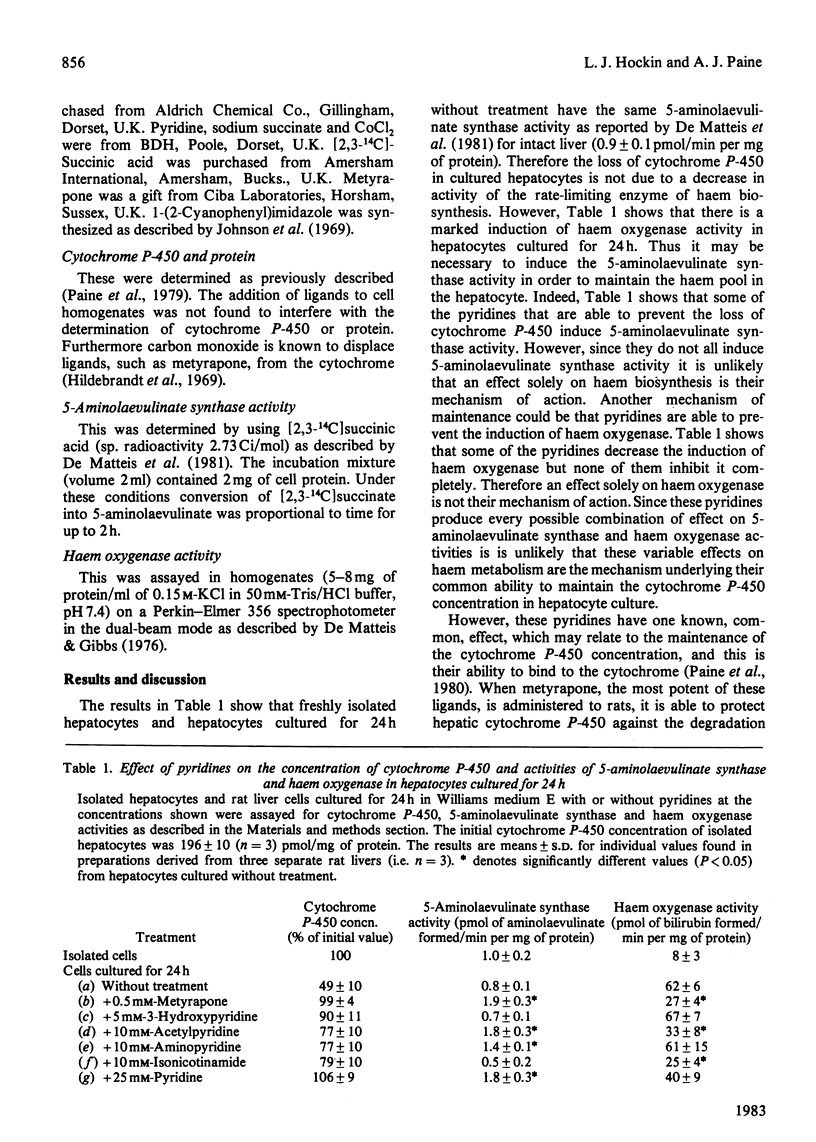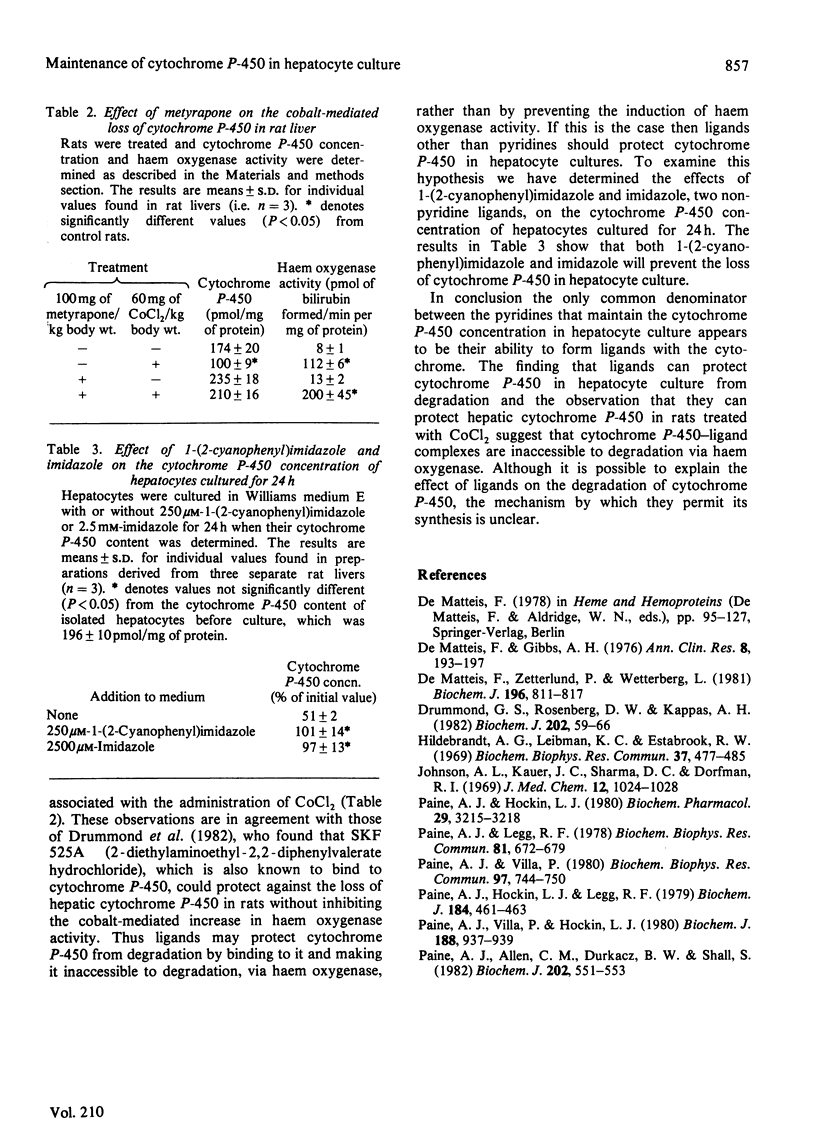Abstract
The present work shows that the ability of pyridines e.g. metyrapone, to maintain the cytochrome P-450 concentration in cultured hepatocytes is not due to their ability to alter the 5-aminolaevulinate synthase and haem oxygenase activities of the hepatocytes. Since ligands such as metyrapone will prevent the cobalt-mediated loss of hepatic cytochrome P-450 in rats, the hypothesis that ligand formation is the mechanism of maintenance of the cytochrome in hepatocyte culture was tested. The observation that non-pyridine ligands will maintain the cytochrome P-450 concentration supports this hypothesis.
Full text
PDF


Selected References
These references are in PubMed. This may not be the complete list of references from this article.
- De Matteis F., Gibbs A. H. The effect of cobaltous chloride on liver haem metabolism in the rat. Evidence for inhibition of haem synthesis and for increased haem degradation. Ann Clin Res. 1976;8 (Suppl 17):193–197. [PubMed] [Google Scholar]
- De Matteis F., Zetterlund P., Wetterberg L. Brain 5-aminolaevulinate synthase. Developmental aspects and evidence for regulatory role. Biochem J. 1981 Jun 15;196(3):811–817. doi: 10.1042/bj1960811. [DOI] [PMC free article] [PubMed] [Google Scholar]
- Drummond G. S., Rosenberg D. W., Kappas A. Metal induction of haem oxygenase without concurrent degradation of cytochrome P-450. Protective effects of compound SKF 525A on the haem protein. Biochem J. 1982 Jan 15;202(1):59–66. doi: 10.1042/bj2020059. [DOI] [PMC free article] [PubMed] [Google Scholar]
- Hildebrandt A. G., Leibman K. C., Estabrook R. W. Metyrapone interaction with hepatic microsomal cytochrome P-450 from rats treated with phenobarbital. Biochem Biophys Res Commun. 1969 Oct 22;37(3):477–485. doi: 10.1016/0006-291x(69)90940-1. [DOI] [PubMed] [Google Scholar]
- Johnson A. L., Kauer J. C., Sharma D. C., Dorfman R. I. The synthesis of 1-arylimidazoles, a new class of steroid hydroxylation inhibitors. J Med Chem. 1969 Nov;12(6):1024–1028. doi: 10.1021/jm00306a013. [DOI] [PubMed] [Google Scholar]
- Paine A. J., Allen C. M., Durkacz B. W., Shall S. Evidence that poly(ADP-ribose) polymerase is involved in the loss of NAD from cultured rat liver cells. Biochem J. 1982 Feb 15;202(2):551–553. doi: 10.1042/bj2020551. [DOI] [PMC free article] [PubMed] [Google Scholar]
- Paine A. J., Hockin L. J., Legg R. F. Relationship between the ability of nicotinamide to maintain nicotinamide-adenine dinucleotide in rat liver cell culture and its effect on cytochrome P-450. Biochem J. 1979 Nov 15;184(2):461–463. doi: 10.1042/bj1840461. [DOI] [PMC free article] [PubMed] [Google Scholar]
- Paine A. J., Hockin L. J. Nutrient imbalance causes the loss of cytochrome P-450 in liver cell culture: formulation of culture media which maintain cytochrome P-450 at in vivo concentrations. Biochem Pharmacol. 1980 Dec 1;29(23):3215–3218. doi: 10.1016/0006-2952(80)90590-0. [DOI] [PubMed] [Google Scholar]
- Paine A. J., Legg R. F. Apparent lack of correlation between the loss of cytochrome P-450 in hepatic parenchymal cell culture and the stimulation of haem oxygenase activity. Biochem Biophys Res Commun. 1978 Mar 30;81(2):672–679. doi: 10.1016/0006-291x(78)91589-9. [DOI] [PubMed] [Google Scholar]
- Paine A. J., Villa P., Hockin L. J. Evidence that ligand formation is a mechanism underlying the maintenance of cytochrome P-450 in rat liver cell culture. Potent maintenance by metyrapone. Biochem J. 1980 Jun 15;188(3):937–939. doi: 10.1042/bj1880937. [DOI] [PMC free article] [PubMed] [Google Scholar]
- Paine A. J., Villa P. Ligands maintain cytochrome P-450 in liver cell culture by affecting its synthesis and degradation. Biochem Biophys Res Commun. 1980 Nov 28;97(2):744–750. doi: 10.1016/0006-291x(80)90327-7. [DOI] [PubMed] [Google Scholar]


